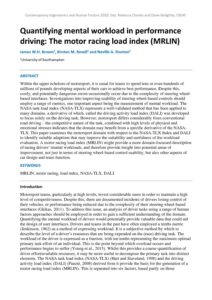| Document | Author James W.H. Brown, Kirsten M. Revell and Neville A. Stanton |
| Abstract Within the upper echelons of motorsport, it is usual for teams to spend tens or even hundreds of millions of pounds developing aspects of their cars to achieve best performance. Despite this, costly, and potentially dangerous errors occasionally occur due to the complexity of steering wheel-based interfaces. Investigations into improving usability of steering wheel-based controls should employ a range of metrics, one important aspect being the measurement of mental workload. The NASA task load index (NASA-TLX) represents a well-validated method that has been applied to many domains, a derivative of which, called the driving activity load index (DALI) was developed to focus solely on the driving task. However, motorsport differs considerably from conventional road driving – the competitive nature of the task, combined with high levels of physical and emotional stresses indicates that the domain may benefit from a specific derivative of the NASA-TLX. This paper examines the motorsport domain with respect to the NASA-TLX Index and DALI to identify suitable adaptions that may improve the suitability and usefulness of the workload evaluation. A motor racing load index (MRLIN) might provide a more domain-focussed description of racing drivers’ mental workloads, and therefore provide insight into potential areas of improvement, not just in terms of steering wheel-based control usability, but also other aspects of car design and team function. |

